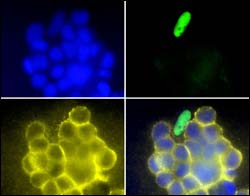Ewing’s sarcoma : Discovery of a "link" in tumor growth

When cells express the abnormal protein… In these cells, the blue, green and yellow labeling respectively corresponds to the nucleus, the abnormal protein EWS/FLI-1 and the protein IGFBP-3. In the cells where EWS/FLI-1 is present (green labeling), IGFBP-3 is absent (no yellow labeling), confirming that EWS/FLI1 prevents expression of the IGFBP-3 gene. A. Prieur/Institut Curie
To develop new therapeutic approaches to cancer, it is essential to understand the long and extremely complex process that underlies it, in other words the various stages of cancer development from the initial mutation to the tumor. Having already identified the alteration that leads to Ewing’s sarcoma, a bone cancer which afflicts young people, an Inserm team at the Institut Curie has recently used a combination of novel techniques to show that there 86 deregulated genes in these tumors. One of these genes, a new “link” in the development of Ewing’s sarcoma, could be used as a therapeutic target. These discoveries were published in the August 2004 issue of Molecular and Cellular Biology.
Cancer results from the proliferation of abnormal cells in the body. The trigger is an alteration in the genetic material of a single cell, in certain genes that regulate vital processes (division, differentiation, apoptosis, repair). However, a single mutation is not enough to transform a health cell into a cancer cell. Rather it is a succession of genetic accidents that results in uncontrolled cells that accumulate and lead to tumor formation.
Few cancers have a simple molecular signature – a specific mutation that leads to tumor growth. In Ewing’s sarcoma, a malignant tumor of the bone which affects children, teenagers and young adults, this molecular signature has been discovered thanks to a close collaboration between physicians and researchers at the Institut Curie, the internationally renowned reference center for the study and treatment of Ewing’s sarcoma.
Olivier Delattre(1) and his group have identified and characterized this mutation: it arises from an accidental exchange of genetic material between two chromosomes. This leads to the formation of a mutated gene that produces an abnormal protein called EWS/FLI-1 (see box overleaf). To understand the growth of Ewing’s sarcoma, Delattre and colleagues are now studying the effects of EWS/FLI-1 on the cellular machinery. They use an original approach in which the technique of RNA interference(2) is used to “switch off” the mutated gene. The abnormal protein is therefore no longer produced. Using DNA chips, they have studied how other genes are affected by the absence of the abnormal protein.
When a “brake” on proliferation is released…
With this combination of innovative techniques, Delattre and colleagues have identified 86 genes whose expression is altered in the absence of the abnormal protein. They have paid particular attention to one of these genes – the IGFBP-3 gene – whose expression is greatly reduced in tumor cells but which is again expressed normally when the altered protein is absent. The protein produced by the IGFBP-3 gene is known to block one of the most important cellular messengers, insulin-like growth factor 1. IGF-1 controls several fundamental mechanisms such as cellular proliferation and apoptosis (cell death). Overexpression of IGF-1 has, moreover, been implicated in certain cancers.
The Institut Curie researchers have thus shown in Ewing’s sarcoma that the altered protein prevents expression of the IGFBP-3 gene. As a consequence, IGF-1 is no longer “blocked” and so emits a continuous signal ordering the cells to proliferate. IGFBP-3 plays a role upstream in this signaling pathway and could be targeted therapeutically to block IGF-1-induced abnormal cellular proliferation.
Olivier Delattre and his team at the Institut Curie have therefore discovered a new “link” in the growth of Ewing’s sarcoma. Through better comprehension of the cascades of deregulations specific to each tumor, it will be possible to develop new therapeutic strategies that are better targeted and hence more effective.
Media Contact
All latest news from the category: Life Sciences and Chemistry
Articles and reports from the Life Sciences and chemistry area deal with applied and basic research into modern biology, chemistry and human medicine.
Valuable information can be found on a range of life sciences fields including bacteriology, biochemistry, bionics, bioinformatics, biophysics, biotechnology, genetics, geobotany, human biology, marine biology, microbiology, molecular biology, cellular biology, zoology, bioinorganic chemistry, microchemistry and environmental chemistry.
Newest articles

Not Lost in Translation: AI Increases Sign Language Recognition Accuracy
Additional data can help differentiate subtle gestures, hand positions, facial expressions The Complexity of Sign Languages Sign languages have been developed by nations around the world to fit the local…

Breaking the Ice: Glacier Melting Alters Arctic Fjord Ecosystems
The regions of the Arctic are particularly vulnerable to climate change. However, there is a lack of comprehensive scientific information about the environmental changes there. Researchers from the Helmholtz Center…

Global Genetic Insights into Depression Across Ethnicities
New genetic risk factors for depression have been identified across all major global populations for the first time, allowing scientists to predict risk of depression regardless of ethnicity. The world’s…



